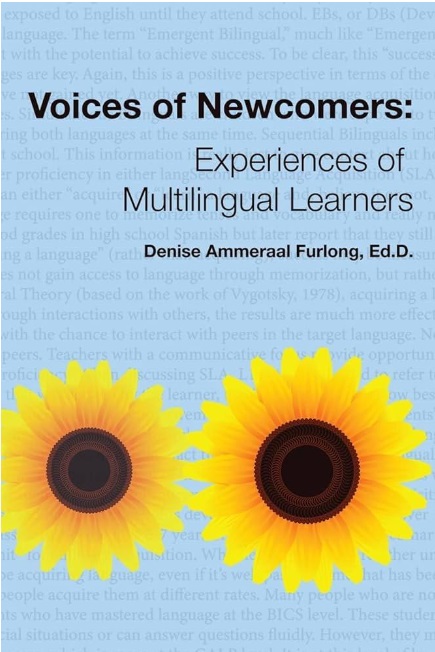Michelle Skowbo
Voices of Newcomers: Experiences of Multilingual Learners by Denise Ammeraal Furlong
By Lisa Fischler
Voices of Newcomers: Experiences of Multilingual Learners by Denise Ammeraal Furlong offers a practical guide with timely steps to “maximizing the learning experience that educators provide” for multilingual learners (MLs), students new to education in the U.S. (Newcomers), and “SLIFE (Students with Limited or Interrupted Formal Education)” (p. xii). Set within the context of culturally responsive pedagogy, the short introduction and eleven additional chapters demonstrate very helpful ways to cultivate inclusive, connective, welcoming, and supportive scholastic communities for the students comprising MLs, Newcomers, and SLIFEs. This accessible book reads easily and will be of interest to K-12 schools, including their instructors, staff, and students, particularly those who are most responsible for assisting MLs, Newcomers, and SLIFEs.
The first two chapters provide useful background information. Chapter 1 details the meanings of acronyms for the students of concern in this volume and the terms related to their language learning. Chapter 2 gives a checklist of important knowledge for instructors related to students’ previous experiences and resources they will need. The chapter also emphasizes age-appropriate support for ESL students, the appropriate questions for instructors to ask, and approaches to student placement. In addition, both chapters offer reflection questions, discussion questions, and authentic voices of students related to the chapters’ topics.
The next two chapters address initial issues to consider when starting to incorporate multilingual learners into a school. Chapter 3 discusses students’ arrival at the school. Chapter 4 considers the ways in which cultures can be infused appropriately into the school community and classroom content. Both chapters stress the importance of building connections and community in order to best situate MLs, Newcomers, and SLIFEs into a safe space where they feel comfortable taking risks in learning. Additionally, both chapters remind us that “the key to cultural competence is authenticity” (p. 68).
Chapters 5 and 6 are opposite sides of the coin known as language learning. Chapter 5 lays out multimodal ways to utilize the differing native languages of multilingual learners in the classroom, including anchor charts and visuals. The chapter underscores the importance of differentiation in instruction and multiple learning supports. Chapter 6 offers ways in which understandable English can be used to give strong support to Newcomers. Activating schema, scaffolding, and treatment of errors are all highlighted in this chapter. Like all the other chapters, reflection questions, discussion, and authentic voices of students related to each topic are included.
The next three chapters emphasize the provision of opportunity, support, patience and empathy on the part of instructors and the school community. Chapter 7 details ways in which instructors can best support MLs, Newcomers, and SLIFEs in developing literacy in English. One key is to teach with “dignity and a growth mindset"(p. 113). Another is not to confuse the issues Newcomers bring with them that manifest on initial assessments and special education needs as they are usually not the same. Chapter 8 discusses different types of assessing multilingual learners, especially formative assessments, but also discusses ways in which assessments can be adapted and modified to help support Newcomers. Chapter 9 extends the book’s discussion to the issue of MLs’, Newcomers’, and SLIFEs’ families, pointing out the different familial situations students may find themselves in once they come to the U.S. The main importance these chapters show is to see the complete or “whole” picture of each student.
The last two substantive chapters illuminate the additional challenges facing Newcomers when working on learning English. Chapter 10 underscores the topic of remote learning and its associated issues. Chapter 11 focuses on other differences among students, such as socioeconomic status, the influence of trauma (past and present), safety, absences, and learning disabilities. Both chapters emphasize the ways in which school communities can work together to empathetically understand these differences and to overcome them. The short final chapter functions as a coda that represents a review of the purpose of the book. It reinforces the importance of the patience, support, and empathy needed by school communities to best support MLs, Newcomers, and SLIFEs so that they can “achieve great things” because “people [believed] in them” (p. 180).
The unconventional additions to each chapter, like the reflection questions, discussions, and authentic voices of students, as well as the references and the appendices for each chapter make this volume an unexpected pleasure to read. It also makes the book a “way to spark conversation and inspire creativity in working with MLs” (p. 179). Not only K-12 school communities, but all those deeply concerned with finding sustainable ways to support MLs, Newcomers, and SLIFEs in their language learning will benefit from the material presented so diversely in this text.
